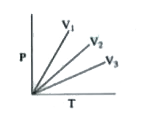For an ideal gas, under isobaric condition, a graph between log V vs log T :
is linear with unit slope
represents Boyle’s Law
represents Charle’s Law
represents Gay-Lussac’s Law
The correct Answer is:A, C
To solve the question regarding the graph between log V vs log T for an ideal gas under isobaric conditions, we can follow these steps:
1. Understand the Ideal Gas Law:
The ideal gas law is given by the equation:
PV=nRT
where P is the pressure, V is the volume, n is the number of moles, R is the universal gas constant, and T is the absolute temperature.
Hint: Remember that the ideal gas law relates pressure, volume, temperature, and the number of moles.
2. Identify Isobaric Conditions:
Under isobaric conditions, the pressure P remains constant. This means we can express the relationship between volume and temperature while keeping P constant.
Hint: Isobaric means pressure does not change; focus on how volume and temperature relate under this condition.
3. Establish the Relationship:
Since P is constant, we can rearrange the ideal gas law to show that volume V is directly proportional to temperature T:
V∝T
This indicates that as temperature increases, volume also increases.
Hint: Think about direct proportionality—if one increases, the other must also increase.
4. Convert Proportionality to an Equation:
We can express this relationship as:
V=kT
where k is a constant.
Hint: This equation shows a linear relationship between volume and temperature.
5. Take the Logarithm of Both Sides:
Taking the logarithm of both sides gives:
logV=log(kT)=logk+logT
This can be rearranged to:
logV=logT+logk
Hint: Remember that the logarithm of a product is the sum of the logarithms.
6. Identify the Linear Relationship:
The equation logV=logT+logk is in the form of a straight line y=mx+c, where:
- y=logV
- x=logT
- m=1 (slope)
- c=logk (y-intercept)
Hint: Recognize that this represents a linear graph with a slope of 1.
7. Conclusion:
Since the graph of logV versus logT is linear with a unit slope, it represents Charles' Law, which states that at constant pressure, the volume of a gas is directly proportional to its absolute temperature.
Hint: Recall that Charles' Law specifically deals with volume and temperature at constant pressure.
Final Answer:
The graph between log V vs log T for an ideal gas under isobaric conditions is linear with a unit slope and represents Charles' Law.
The ideal gas law is given by the equation:
PV=nRT
where P is the pressure, V is the volume, n is the number of moles, R is the universal gas constant, and T is the absolute temperature.
Under isobaric conditions, the pressure P remains constant. This means we can express the relationship between volume and temperature while keeping P constant.
Since P is constant, we can rearrange the ideal gas law to show that volume V is directly proportional to temperature T:
V∝T
This indicates that as temperature increases, volume also increases.
We can express this relationship as:
V=kT
where k is a constant.
Taking the logarithm of both sides gives:
logV=log(kT)=logk+logT
This can be rearranged to:
logV=logT+logk
The equation logV=logT+logk is in the form of a straight line y=mx+c, where:
- y=logV
- x=logT
- m=1 (slope)
- c=logk (y-intercept)
Since the graph of logV versus logT is linear with a unit slope, it represents Charles' Law, which states that at constant pressure, the volume of a gas is directly proportional to its absolute temperature.
The graph between log V vs log T for an ideal gas under isobaric conditions is linear with a unit slope and represents Charles' Law.
Topper's Solved these Questions
- BOOK - VMC MODULES ENGLISHCHAPTER - STATES OF MATTEREXERCISE - Level-2 (NUMBERICAL VALUE TYPE FOR JEE MAIN15videos
STATES OF MATTER
- BOOK - VMC MODULES ENGLISHCHAPTER - STATES OF MATTEREXERCISE - JEE-Main ( ARCHIVE )17videos
STATES OF MATTER
- BOOK - VMC MODULES ENGLISHCHAPTER - STATES OF MATTEREXERCISE - Level-175videos
STATES OF MATTER
- BOOK - VMC MODULES ENGLISHCHAPTER - STATES OF MATTEREXERCISE - IMPECCABLE50videos
STATES OF MATTER
- BOOK - VMC MODULES ENGLISHCHAPTER - STOICHIOMETRY - IEXERCISE - JEE Advanced (Archive)31videos
STOICHIOMETRY - I
Similar Questions
Knowledge Check
- Question 1 - Select One
A gas that follows Boyle's law, Charle's law and Avogadro's law is called an ideal gas. Under what conditions a real gas would behave ideally ?
AUnder low pressure and temperatureBUnder high pressure and temperatureCUnder high pressure and low temperatureDUnder low pressure and high temperature
Under isochoric condition, graphs between P and T are shown below.Then volumes of gases are related as
 View Solution
View SolutionA gas that follos Boyle's law, charle's law and Avogadro's law is called an ideal gas. Under what conditions a real gas would behave ideally ?
View SolutionA gas behave most like an Ideal gas under conditions of
View SolutionIn an adsorption experiment, a graph between log (xm) versus log P was found to be linear with a slope of 45∘ . The intercept on the log (xm) axis was found to be 0.3010 . Calculate the amount of the gas adsorbed per gram of charcoal under a pressure of 0.5 atm .
View SolutionIn an adsorption experiment, a graph between log (xm) versus log P was found to be linear with a slope of 45∘ . The intercept on the log y axis was found to be 0.301 . Calculate the amount of the gas adsorbed per gram of charcoal under a pressure of 3.0 atm.
View SolutionWhat is molar volume of an ideal gas under N.T.P. conditions ?
View SolutionIn an adsorption experiment a graph between log xm versus log P was fond to be linear with a slope of 45∘). The intercept on the log xm axis was found to 0.70. Calculate the amount of gas adsorbed per gram of charcoal under a pressure of 1 atm [log5=0.70]
View Solution
